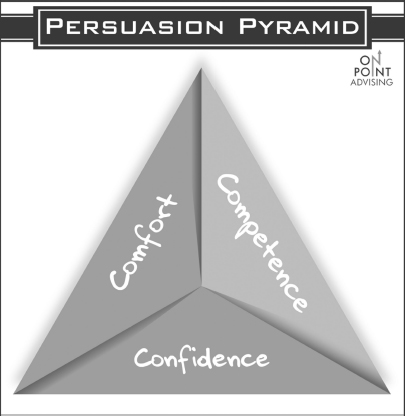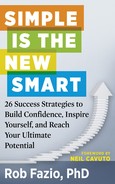16
Passive Persuasion
The Persuasion Pyramid
Your ability to persuade will have a direct impact on how effective you are at getting what you want when you want. Persuasion is a skill, just like writing a report. It’s a big part of success and if you don’t develop this skill, others will, and you will always be persuaded as opposed to the one persuading. When you take a passive approach to persuasion you leave too much up to chance and your probability of success decreases.
Persuading and influencing others is not something that comes naturally to all people. Whether persuasion comes naturally to you or not is less important than the fact that you can develop a strong ability to persuade if you want. Let’s start with a major challenge that I see many people have when they want to be persuasive and fail. I call it finishing before you start. This is when people have already convinced themselves that they won’t be able to persuade someone to their point of view. They make their feelings into facts, rather than just a data point.
For example, I was working with an executive, let’s call him Steve, who always gave up before he tried. He wanted to demonstrate to his boss that there was a better way to approach the way they were working. When we initially started talking about how he could influence his boss, his first response was, “My boss will never go for this.” My client was absolutely convinced that no matter what, his boss would shoot him down and his point of view wasn’t worth raising. Once Steve convinced himself his boss wasn’t going to value his opinion, he was finished before he started. Steve set himself up for failure. His thought process, nonverbal messages, and beliefs all followed what he told himself.
I knew we needed to change the narrative from Steve knowing he wasn’t going to be successful in influencing, to knowing he was going to be successful. After years of coaching executives and athletes I’ve learned it’s not always about intellect and logic, but about something else. So we needed to find a way for Steve to go from finishing before he started to starting before he finished. In other words, Steve needed to give himself a chance and it started with his mindset.
Simple Success Strategy: The Persuasion Pyramid
So, what did we do? We started with the three core aspects of successful persuasion: confidence, competence, and comfort. I call this the Persuasion Pyramid. You can get by if you have one without the other, but you need all three to be successful at influencing on a consistent basis. Confidence is your belief that you can influence someone or a group of people. Competence is having the skills to be influential. Comfort is being okay over being empowered and influential. Just because you are effective at persuading, doesn’t necessarily mean you are doing anything wrong or taking advantage of someone. Actually, the opposite is true, the more persuasive you are, the more you can help others help themselves.
When you are able to diagnose in which area your challenges typically lay, you can do something to be more effective. The following is a snapshot of the three core areas of the Persuasion Pyramid.
The Persuasion Pyramid will help you become aware of where you need to focus. Persuasion starts with yourself. The more confidence you have, the more comfortable you will be and the higher your probability of successful influence will be. Each of the following characteristics, being calculated, credible, and concise, will help you gain confidence, competence, and comfort with time. Focus on developing them and you will see your capability grow.
Calculated
The more intentional and strategic you are, the better able you will be to respond in the moment. Think through what the other person is likely to say and how they will react. Identify what topics may come up that could throw you off your focus. Know what you want prior to the conversation. It is also very beneficial to know what the other person’s motivational currency is (Chapter 15) and which conversation character (Chapter 20) he or she is aligned with.

Credible
The notion of credibility has been researched and popularized by two thought leaders in the leadership space, Kouzes and Posner (2003). They wrote the book on credibility: Credibility: How Leaders Gain and Lose It, Why People Demand It. What I have learned from their work, as well as working with executives, is that there is a pretty simple equation related to credibility and persuasion. The more credible you are, the easier it is for you to persuade people. The people around you determine your credibility. They determine this by what you say and what you do. The good news is that you can influence your credibility. Some of the key building blocks of credibility are transparent communication, following through on commitments, managing your emotions, and treating people with respect. People also view leaders as credible when they are visionary and demonstrate the confidence and conviction to make a decision or give an unpopular point of view. It takes a lot of time to build your credibility and very little time to deplete it. Do you know anyone who wants to work for someone whom they can’t trust?
Persuasion Pyramid Description

Concise
As I am confident you have already heard, communication is a key factor in whether or not we are effective. I was coaching an executive who was very gifted in the technology space. He was brilliant, but could not break his habit of being overly verbose. His communication style was the biggest barrier to success. People would tune him out as soon as he started talking because they knew he was going to be long-winded.
People are busy; they want information fast and in a concise manner. Many people get caught up in wanting to showcase how much time they spent uncovering information and research. The point is, though, how long it took you to add value is irrelevant—it’s how effectively you can deliver value that is relevant.
A way to increase your chances of being an effective and concise communicator is to follow a simple framework: overview, review, and point of view. Overview is the headline, a way to let the person know where you are going. It’s brief and catches the person’s attention. Review is a snapshot of 3–5 key points. Think of them as bullet points that support your overview. Point of view is the bottom line. It’s your recommendation, suggestion, or even key question that you have. It’s where you land. This type of communication forces you to synthesize and think through what is most relevant.
This type of communication can be used in one-on-one conversations, presentations, and e-mails. Again, you can always provide more detailed information. Your ability to master this style of communication will greatly increase your chances of being viewed as credible and a valuable contributor.
We cannot control what others do and decide. However, we can have a great deal of influence on what people do and decide. I’m not suggesting that you want to be pushing people around, but I am suggesting that you want to be really good at getting people to see different things in different ways, and you will want to do the same for others.
